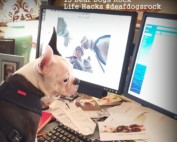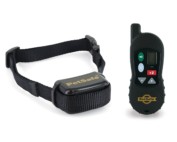Since I am constantly searching for articles on deaf dogs, I thought our Deaf Dogs Rock readers would appreciate the information I found in this article written by Elisabeth Catalano, MA, CPDT, CDBC. The article is very well written, insightful,educational and gets to the heart of the matter when it comes to training a deaf dog. Here at Deaf Dogs Rock it is our mission to educate as many people as we can when it comes to training, challenges and facts about deaf dogs. By teaching people deaf dogs can become wonderful dogs with patience and training, maybe we can save more deaf dogs from ending up on death row. The author Elisabeth Catalano states in her Things To Consider section “Owning a deaf dog is not to be taken lightly. There are serious training and safety considerations that make it a huge commitment of time, energy and patience. While some breeds come equipped with traits that make them easy to work with, other breeds possess traits that make them more independent and aloof. Deafness in these dogs can exacerbate training problems.”
If you get a chance, I highly encourage you to read the full article. ~ Christina Lee – Deaf Dogs Rock
BREAKING THE SOUND BARRIER: Living with and Training the Deaf Dog By: Elisabeth Catalano, MA, CPDT, CDBC
When I tell people that the sweet little white dog they have been playing with is deaf, I get the same response, a sad, troubled look and an “Oh, that’s too bad”. I always reply with a big grin, “It’s ok, he doesn’t know it”! And, he DOESN’T. Never having heard anything, as far as I know, he doesn’t know what he’s missing. His world is perfectly normal to him. Announcement of his deafness is often followed by astonishment, usually because he is so friendly and well behaved. “Is it hard to train him?” My answer is always an unqualified, “No!”
With some limitations, it is very possible to train a deaf dog. Trainers often fail to see the potential in these dogs – not to mention the benefit of their own skill development. The deaf dog can increase awareness of our own non- verbal communication. Trainers, and more importantly humans, rely heavily on sound, but the deaf dog can force you to be more creative. Communication for dogs has always been far beyond sound; the deaf dog causes us to embrace that fact. There are some advantages in working with deaf dogs, too: no fear of loud noises, no getting distracted by barking and no hearing the rustling of the food pouch!
Deaf dogs can and should be encouraged to attend regular obedience classes, which use positive training/lure reward methods, because the hand signals are largely the same. They can and do compete in the sports of obedience, rally and agility (with the exception of AKC events) and many are therapy dogs
Studies on the prevalence of deafness in dogs are limited, but it is estimated that thousands of dogs are born deaf each year. Eighty different breeds are affected by deafness and that number is increasing. Additionally, dogs can and do lose their hearing as a result of illness,infection, trauma or old age. Unfortunately, many deaf dogs are euthanized due to irrational myths and a lack of understanding. The Dalmatian Club of America has an official position calling for the euthanasia of deaf puppies. Dogs that lose their hearing later on in their lives may have an adjustment period, but adapt well. All deaf dogs can lead normal, happy and full lives that differ little from their hearing counterparts. They only require a little patience and a creative trainer, willing to think outside the box. The two most pervasive myths regarding deaf dogs are that they are brain damaged or are more prone to aggression. In the case of deaf Dalmatians, it was shown that the portion of the brain (the auditory cortex) that deals with auditory impulses was greatly reduced in size. George M. Strain, PhD,however, writes in the same article: “The brain responds to the loss of a sensory modality by various forms of plasticity, whereby CNS structureshat would have received input from that sensory modality constrict and adjacent structures expand to take advantage of the available space.”According to Dr. Strain, “The findings in the Dalmatian are undoubtedly a reflection of the same pathology”. He further summarized that “… these animals do not have diminished mental capacities, any more than the average deaf or blind human has diminished mental capacity.” (“Aetiology, prevalence and diagnosis of deafness in dogs and cats.” British Veterinary Journal 152:17-36, 1996, Baillière Tindall)
There are simply no studies quantifying the prevalence of aggressed by those who claim a higher incidence of aggression is that the deaf dog will startle easily and bite. Realistically, any startled dog can bite. While it may be easier to startle a deaf dog, good preventative training can minimize problems. Wake the deaf dog gently by blowing a gentle puff of air across his fur or lightly touching him. When he wakes, smile and call him to do something fun. Using high-value food will also make the transition to waking more pleasant, especially for dogs whose history is unknown. Traditional classical conditioning/desensitization exercises for touch can take the edge off the startle effect and even make it a welcome event.
COUNSELING
While training a deaf dog can be challenging and rewarding, you should be prepared to do a little work up front before you offer your services or welcome them into an obedience or puppy class. You will be counseling owners that have unexpectedly found they are living with a deaf dog and have no idea what to do.
Owners that have just discovered that the cute little puppy that they are in love with is deaf are often disappointed and worried. They may feel overwhelmed by the prospect and the responsibility of training a deaf dog. Owners whose dogs have lost or are losing their hearing are sad and may worry about quality of life. You may be the deaf dog owners first, only or last resource. The information you give them will determine that particular dogs’ outcome. It is important that you provide them with accurate, effective information and lots of hope.
I remember how I felt the first time I realized that I would never see my puppy “light up” when I called his name. It is something that I had always enjoyed, but had taken for granted with my other dogs. Knowing I would never have that made me sad. One day, not long after Nevar joined us, I found him playing with the other dogs. I waved my arms high over my head to catch his attention, and there it was! The bright look, the perked ears! No hearing, but pure joy just the same That is how it is with the deaf dog, the same, but different.
THINGS TO CONSIDER
Owning a deaf dog is not to be taken lightly. There are serious training and safety considerations that make it a huge commitment of time, energy and patience. While some breeds come equipped with traits that make them easy to work with, other breeds possess traits that make them more independent and aloof. Deafness in these dogs can exacerbate training problems.
Many ordinary scenarios can pose a risk to the deaf dog. Enter my backyard on any given day when the dogs are out and I promise, they will know you are there long before you reach the gate. The deaf dog however, may be unaware of a visitor’s arrival and be overlooked. Gates may be left open simply because no one knew the dog was even there. Signs advising visitors that “a deaf dog is in residence” and to “close all gates”, are a must. Spring- closed gates, should also be used if possible.
Initially, the responsibility of keeping my puppy safe was overwhelming. If a leash came undone, or a car came too close, there was no way to call him out of harm’s way. What if my attention was diverted? He could not hear approaching danger and react. Having a deaf dog means being diligently aware of what is going on around you and being prepared for possible dangers.
Supervision plays a key role in any early training, but it is particularly demanding with the deaf dog. You must be close to get his attention. Eh-eh won’t work! You will have to go to him in order to redirect him to something else. After getting my pups attention, I used a wag of my finger, a traditional “no-no” sign when I stopped the behavior and then moved him on to something else.
Click here to read the full article.









